Abstract
Combined non-destructive in situ techniques—namely sonic tests and ambient vibration measurements—are applied on two Nepali Pagoda temples damaged by the 2015 Gorkha earthquake, providing the dynamic elastic modulus of masonry and the buildings’ frequencies.
1. Introduction and Methods
Nepal has a long seismic history due to its location on a very active tectonic zone, as the result of the subduction of the Indian plate under the Eurasian Plate. Major earthquakes were reported in 1255, 1810, 1866, 1934, 1980, 1988 and 2015. The 1934 Nepal-Bihar earthquake (Mw 8.0) destroyed more than 80,000 buildings and claimed 8500 lives [1,2]. The 2015 Gorkha earthquake (Mw 7.8) destroyed half million homes, causing more than 8790 deaths and 22,300 injuries [3]. Cultural heritage, mainly consisting of temples and palaces, suffered heavy damage as well [4].
Nepali Pagoda temples appeared around the middle of 14th century during the Malla Dynasty. They consist of brick masonry and timber members. The main features of Pagoda temples are their considerable wall thickness, multi-tiered roof and box type configuration [5,6]. The main weaknesses of Pagoda temples under seismic actions are: (a) lack of transverse connection in multi-leaf brick masonry; (b) lack of vertical continuity of the walls—upper walls rest on timber beams to form a kind of inward cantilever; (c) large weight of the top roof, arcades at the base resulting in soft ground floor [7].
This study presents an experimental investigation on two Nepali Pagoda temples damaged by the 2015 Gorkha Earthquake, namely Jagannath Temple in Kathmandu Durbar Square and Krishna Temple in Bhaktapur Durbar Square.
Non-destructive techniques (NDTs) for the in situ evaluation of civil structures are well known and widely used with the aim of identifying hidden construction elements, calibrating mechanical parameters, assessing the level of damage and/or the state of preservation [8,9]. Currently, the most used NDTs are: sonic and ultrasonic tests, ground-penetrating radar, pachometer, rebound hammer, thermography and dynamic monitoring under an exciting device or ambient vibrations measurements (AVMs) [10,11]. Minor-destructive in situ tests, e.g., mortar penetration tests and flat jacks, or sampling for laboratory tests, are very common as well.
The research field of NDTs is rather complex from the scientific point of view and there is still the need to understand the potential of combining a number of different techniques. The aim of this research is to investigate the interaction of AVMs and sonic tests (STs), with special emphasis on damage level assessment and on expected seismic collapse mechanism.
2. Results
The experimental results related to STs to evaluate the level of compactness in damaged and undamaged parts of masonry, and to AVMs on historic temples are presented. Specifically, the experimental investigation was carried out on Jagannath Temple in Kathmandu Durbar Square [12,13] and Krishna Temple in Bhaktapur Durbar Square.
2.1. The Case of Jagannath Temple in Kathmandu Durbar Square
The first historic construction investigated with both STs and AVMs is Jagannath Temple (Figure 1). STs have been applied in four zones, as indicated again in Figure 1. Some results are reported in Table 1 for zone A. Masonry density has been assumed according to [14].
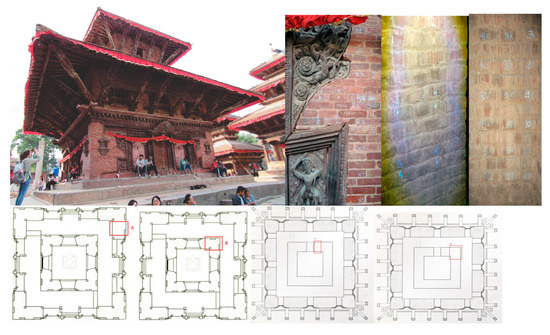
Figure 1.
Jagannath Temple, Kathmandu.

Table 1.
Results of STs, Jagannath Temple.
In detail, the analysis of the results confirms the effects of damage and its distribution. In particular, it is evident from Table 1 that the zone in correspondence of the first floor appears less damaged than that at the ground floor.
AVMs were accomplished on 23 October 2016. The measurements on the south basement were accomplished on 29 October 2016. The locations of the velocimeter are shown in Figure 2. The record duration was 16 min for the south basement, 6 min at the north side of first floor and 10 min for the remaining records. The sampling frequency was 128 Hz. The Fourier amplitude spectra of velocity are shown in Figure 3.
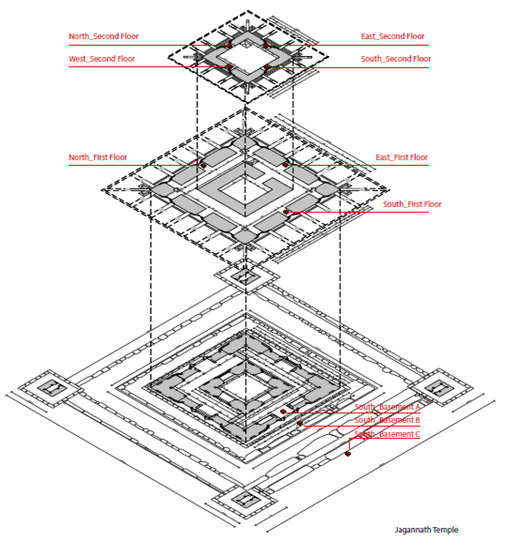
Figure 2.
Locations of the velocimeter, Jagannath Temple.
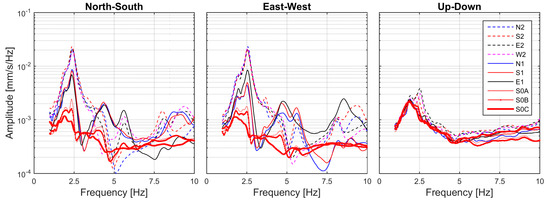
Figure 3.
Fourier amplitude spectra of velocity, Jagannath Temple.
The first two frequencies correspond to the fundamental modes along the NS (f1 = 2.3 Hz) and EW (f2 = 2.5 Hz) directions, respectively. Similarly, the third and fourth frequencies correspond to the second modes along the NS (f3 = 4.3 Hz) and EW (f4 = 4.7 Hz) directions, respectively. The fifth frequency (f5 = 5.6 Hz) corresponds to the first torsional mode around the vertical axis, as the N and S walls move along the EW direction, and the E and W wall along the NS direction. Two frequencies follow (f6 = 8.1 Hz, f7 = 8.6 Hz) without clear indications about their modal shape. The eight frequency (f8 = 9.1 Hz) correspond to the third mode along the NS direction. Finally, the ninth frequency (f9 = 9.4 Hz) corresponds to the second torsional mode around the vertical axis. The measures at the second floor show the typical coupling between the horizontal and the vertical components due to the global bending response of the building. No significant peak was detected at the basement, south side, outside the temple, showing the absence of local amplification effects.
2.2. The Case of Krishna Temple in Bhaktapur Durbar Square
In the case of Krishna Temple (Figure 4), STs, of direct and indirect type, have been applied at the base of the masonry bearing parts, as indicated in Table 2 and Table 3.

Figure 4.
Krishna Temple, Bhaktapur.

Table 2.
Indirect STs, Krishna Temple.

Table 3.
Direct STs, Krishna Temple.
According to well established relations between sonic wave velocity and masonry compactness, Table 2 confirms that the latter is low along both the horizontal and the vertical directions. This is probably due to internal damage and low level of maintenance. Moreover, the very low values of the sonic waves along the vertical direction over short distance (450 mm) highlight the poor mechanical performance of mud mortar joints.
AVMs were accomplished on 24 October 2016. The locations of the velocimeter are shown in Figure 5. The arrows show the instrumental N direction. The duration of each record was 16 min and the sampling frequency 128 Hz. The Fourier amplitude spectra of velocity are shown in Figure 6.
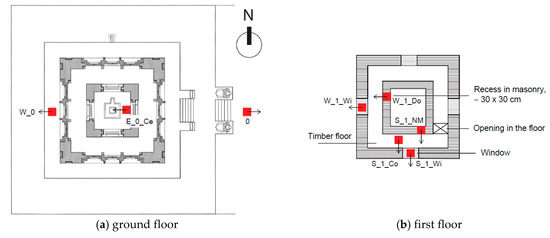
Figure 5.
Locations and orientations of the velocimeter, Krishna Temple.
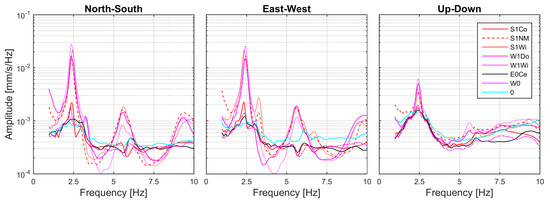
Figure 6.
Fourier amplitude spectra of velocity, Krishna Temple.
The first two frequencies (f1 = 2.3 Hz, f2 = 2.4 Hz) have mixed components, along the NS and EW directions, possibly with torsion. The third frequency (f3 = 3.3 Hz) corresponds to the first torsional mode around the vertical axis (the S wall moves along the EW direction and the W wall along the NS direction). The fourth frequency (f4 = 5.6 Hz) has mixed components along the NS and EW directions. The fifth frequency (f5 = 6.1 Hz) corresponds to the free-field and the basement, showing local amplification effects. Finally, the last three frequencies (f6 = 6.5 Hz, f7 = 9.4 Hz, f8 = 9.8 Hz) have again mixed components along the NS and EW directions. Coupling between the horizontal and the vertical components can be found at the first floor.
3. Potential Interaction between STs and AVMs
The frequency values reported in Section 2.1 with reference to Jagannath Temple evidenced a well-known and recognizable structural behaviour consisting of modes along the principal directions of the building and torsional modes. Horizontal and vertical components are coupled according to global flexural behaviour. The frequency values are in agreement with the level of wave velocity across the thickness of masonry, ranging between 850 and 1700 m/s, with reasonable level of homogeneity and low scatter. However, if we consider that the tests have been carried out on a damaged structure, both STs and AVMs seem to indicate that the dissipation capacity of the monument under seismic actions has been efficient and performing.
Regarding Krishna Temple, both STs and AVMs show a less effective structural performance, which is consistent with higher level of observed damage. More specifically, a potential field of research is the integration of information from dynamic identification by means of AVMs—i.e., natural frequencies and modal shapes for each direction—and those from sonic wave velocity distribution in the walls along the same direction.
4. Preliminary Conclusions
On the basis of the presented investigation, the following conclusions can be drawn:
- -
- Usually, in ND in situ investigations, there is the habit to consider separately the results coming from different techniques. Nevertheless, in the case of historic constructions or monuments, this approach does not take full advantage of surveyed information. Indeed, especially after earthquakes or in any case of observed significant damage, combined interpretation can be of interest. This is the case of STs and AVMs.
- -
- Generally, potential integration of these two tests could be difficult because STs provide local results whereas AVMs global results. In addition, the former are based on hammer induced vibrations, whereas the latter use natural and anthropic vibrations.
- -
- Nevertheless, a potential common point of these techniques is damage identification. More specifically, the natural frequencies and mode shapes along a principal direction, provided by AVMs, can be put in relation with the sonic wave velocity across damaged and non damaged parts of the walls along the same direction.
- -
- When evaluating masonry through STs, as general consensus, a 2000-2500 m/s velocity indicates a good level of compactness. Similarly, for the constructions under consideration, a frequency greater than 2.0 Hz indicates a good level of stiffness. Nevertheless, the proposed investigation is more complex because it aims at accounting together for local (STs) and global (AVMs) measures, even though both are related to vibrations.
- -
- STs and AVMs resulted in good agreement and consistent with the observed structural damage.
Acknowledgments
The support of UNESCO Kathmandu office to IUAV’s damage survey activity in 2017 and 2018, and IUAV’s funding of an international in situ workshop in 2016 are gratefully acknowledged.
References
- United Nations Office for the Coordination of Humanitarian Affairs (OCHA). Nepal: Preparing for an Earthquake in the Kathmandu Valley. 2013. Available online: http://www.unocha.org/story/nepal-preparing-earthquake-kathmandu-valley (accessed on 15 April 2018).
- Jain, S.K. Lessons from Recent Indian Earthquakes. Editorial as Guest Editor of Special Issue on Earthquakes in India. Indian Concr. J. 1998, 72. [Google Scholar]
- Lizundia, B.; Davidson, R.A.; Hashash, Y.M.A.; Olshansky, R. Overview of the 2015 Gorkha, Nepal, Earthquake and the Earthquake Spectra Special Issue. Earthq. Spectra 2017, 33, S1–S20. [Google Scholar] [CrossRef]
- Brando, G.; Rapone, D.; Spacone, E.; O’Banion, M.S.; Olsen, M.J.; Barbosa, A.R.; Faggella, M.; Gigliotti, R.; Liberatore, D.; Russo, S.; et al. Damage Reconnaissance of Unreinforced Masonry Bearing Wall Buildings After the 2015 Gorkha, Nepal, Earthquake. Earthq. Spectra 2017, 33, S243–S273. [Google Scholar] [CrossRef]
- Shakya, M.; Varum, H.; Vicente, R.; Costa, A. Seismic sensitivity analysis of the common structural components of Nepalese Pagoda temples. Bull. Earthq. Eng. 2014, 12, 1679–1703. [Google Scholar] [CrossRef]
- Shakya, M.; Varum, H.; Vicente, R.; Costa, A. Seismic vulnerability and loss assessment of the Nepalese Pagoda temples. Bull. Earthq. Eng. 2015, 13, 2197–2223. [Google Scholar] [CrossRef]
- Theophile, E.; Ranjitkar, R.K. Timber conservation problems of the Nepalese Pagoda temple. In Proceedings of the 8th International Symposium on ICOMOS International Wood Committee, Kathmandu, Nepal, 23–25 November 1992; pp. 85–124. [Google Scholar]
- Russo, S. Integrated assessment of monumental structures through ambient vibrations and ND tests: The case of Rialto Bridge. J. Cult. Herit. 2016, 19, 402–414. [Google Scholar] [CrossRef]
- Russo, S. On the monitoring of historic Anime Sante church damaged by earthquake in L’Aquila. Struct. Control Health Monit. 2013, 20, 1226–1239. [Google Scholar] [CrossRef]
- Gallipoli, M.R.; Mucciarelli, M.; Castro, R.R.; Monachesi, G.; Contri, P. Structure, soil-structure response and effects of damage based on observations of horizontal-to-vertical spectral ratios of microtremors. Soil Dyn. Earthq. Eng. 2004, 24, 487–495. [Google Scholar] [CrossRef]
- Gizzi, F.T.; Masini, N.; Sileo, M.; Zotta, C.; Scavone, M.; Liberatore, D.; Sorrentino, L.; Bruno, M. Building features and safeguard of church towers in Basilicata (Southern Italy). In Proceedings of the 2nd International Congress on Science and Technology for the Conservation of Cultural Heritage, Sevilla, Spain, 24–27 June 2014; Rogerio-Candelera, M.A., Ed.; CRC Press: Boca Raton, FL, USA, 2014; pp. 369–374. [Google Scholar]
- Shrestha, S.; Shrestha, B.; Shakya, M.; Maskey, P.N. Damage Assessment of Cultural Heritage after the 2015 Gorkha, Nepal, Earthquake: A Case Study of Jagannath Temple. Earthq. Spectra 2017, 33, S363–S376. [Google Scholar] [CrossRef]
- NRICPT (National Research Institute for Cultural Properties, Tokyo). Project for Investigation of Damage Situation of Cultural Heritage in Nepal, Tokyo, 2016. Available online: http://www.tobunken.go.jp/japanese/publication/pdf/Nepal_NRICPT_2016_ENG_s.pdf (accessed on 15 April 2018).
- Parajuli, H.R. Determination of mechanical properties of the Kathmandu World Heritage brick masonry buildings. In Proceeding of the 15th World Conference on Earthquake Engineering, Lisboa, Portugal, 24–28 September 2012. [Google Scholar]
Publisher’s Note: MDPI stays neutral with regard to jurisdictional claims in published maps and institutional affiliations. |
© 2018 by the authors. Licensee MDPI, Basel, Switzerland. This article is an open access article distributed under the terms and conditions of the Creative Commons Attribution (CC BY) license (https://creativecommons.org/licenses/by/4.0/).